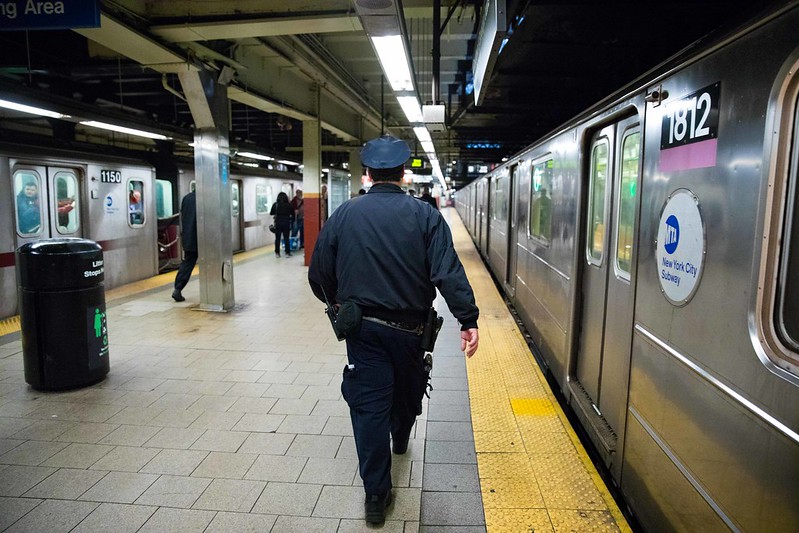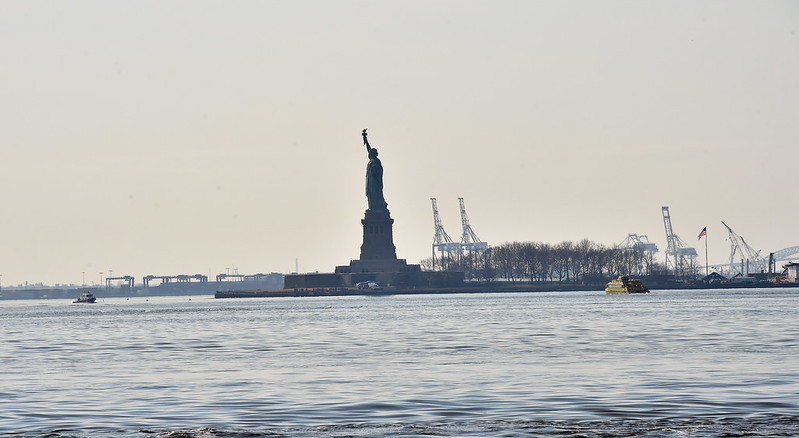New York Must Do More to Prevent Public Transportation from Being a Breeding Ground for Sex Crimes

In the subway system (photo: Benjamin Kanter/Mayoral Photo Office)
Unfortunately fitting for its nickname “the city that never sleeps,” New York City transit sex crimes have a strong case of insomnia. Those who commit these crimes pay no attention to time of day, don’t care if you’re on a station platform or in a subway car. They are fearless, even in the presence of bystanders right next to them, join you as an unwanted guest as you move around the city, then escape past police officers patrolling the next stop.
Unfortunately, official data provided by the NYPD does not specify the number of sex crimes occurring in transit, so the relation between the two is unclear. When comparing data from Quarters 1 and 2 of 2022 and Quarters 1 and 2 of 2023, overall transit crime has reportedly decreased by 7%, while sex crimes other than rape increased by 5% throughout the city. Despite a decrease in transit crime, there are concerns over the sustainability of police officers working overtime in the subway system. Additionally, recent criminal justice reforms have failed to effectively address repeat offenders, especially those who commit violent felonies.
These statistics only tell a portion of the story. Countless more crimes occur every day on the subway but go unreported, much less result in convictions. This past year alone, I was sexually assaulted on the subway, twice. From the moment of contact, I was overcome with hopelessness. I feared immediate retaliation from the offenders had I spoken up, and never reported the crimes because I thought of how easy it would be for my attackers to evade arrest simply by slipping into the anonymity of New York City at the next stop.
My story is far too common. Subway sex crimes have been of public concern since at least 1953. The nature of transportation and the difficulty to surveil such a massive system provides a breeding ground for these transient offenders to go undetected and unidentified. Less than 50% of subway sex crimes lead to an arrest, and the cases that are cleared show a pattern: those who are convicted often have no prior criminal record.
Why isn’t this problem being adequately addressed? The majority of the victims of subway sex crimes are women, and as a society, we still tend to blame the victim for sexual assault, rather than the perpetrator. Some women who have experienced groping, forcible touching, and rape on the subways have reportedly felt afraid and ashamed and don’t come forward to report crimes. They also felt they didn’t have enough time to stop and file a report, or discuss their lack of faith in law enforcement and the government to protect their rights or find their assailant.
Similar to attempts at banning repeat offenders from transit systems related to crimes such as fare evasion or robbery, then-State Senator Diane Savino introduced a bill to address “subway gropers” by classifying forcible touching as a Class D Felony that could result in up to seven years in prison. That bill has repeatedly stalled in the Assembly. Her successor, Senator Jessica Scarcella-Spanton, has expanded upon Savino’s original bill in the current legislative session, legislation currently in the Senate’s codes committee but yet to move.
Others argue for a short-term or lifetime ban of sex offenders from using the transit system. Even if passed, a ban would be very hard to enforce because of the size and scope of the system and that units such as the Transit Special Victims Squad are perennially understaffed and overworked.
Admittedly, the transient environment of the subway makes it extremely difficult to track down offenders, and it’s impossible to staff the entire system with police. Each time I was assaulted, bystanders asked afterwards why I didn’t call the cops. It felt illogical and pointless for me to report a crime that had occurred 10 minutes ago and in a different location from where I currently was, especially if the perpetrator exited the train immediately after the sexual assault and I wasn’t at my destination yet. One of my offenders appeared homeless, and I knew finding and charging him would be even more unlikely.
Although Governor Hochul recently announced the implementation of 5,400 cameras to surveil the transit system, including every subway car, we must currently depend upon blurry and low-resolution stills from security cameras to attempt to find offenders, which proves challenging.
Initiatives that allow victims to speak up and share their stories are important. In 2018, The Call is Yours Campaign and the Transit Sex Offense Awareness website urged victims to report crimes on their own time, which gives the victim a voice, but did not necessarily result in justice. Despite the introduction of such initiatives, it remains nearly impossible to find data that supports their effectiveness.
Many factors that can contribute to a reduction in subway sex crimes may be out of victims’ control, but we can still speak up, and there are actions we can take on our own, such as reintroducing initiatives like The Call is Yours Campaign that allow victims to share their experiences with transit sexual assault.
As I understand what other victims go through, I often ask myself what could have prevented the sexual assaults and how it could be addressed in the aftermath. Research shows that the certainty of suffering consequences for committing a crime, rather than the severity, is effective in deterring such offenses; therefore, if potential offenders know a victim’s reports would lead to real consequences, they may think twice. This means better enforcement and a real commitment to ensuring adequate resources for law enforcement to pursue these cases quickly, with regular reminders via subway announcements about reporting sex crimes, ensuring that victims have a better sense that their claims will be heard and followed.
Awareness campaigns for “The Call is Yours” and the Transit Sex Offense website need to become prominent. I had never heard of either. In fact, the news has not covered The Call is Yours Campaign in recent years. Although the campaign reportedly led to an increase in the number of reported rapes in 2018, no current data is available. I believe it would have been especially beneficial for me and would help other victims who are commuting and unable to immediately stop to report the crime in person had we known of and been able to utilize campaigns that are there to help.
Although fearing retaliation in the moment is a real concern, knowing that soon after the crime occurred I not only could but would be encouraged to report it may have reassured me that New York City cares about this type of crime and these types of victims. Until more is done, I question when anonymity will stop hiding offenders from punishment, and when subway sex crimes won’t appear to be normalized as part of many women’s public transportation experience.
***
Nicole DiMaria is a Master’s candidate in the Forensic Psychology program at John Jay College of Criminal Justice and is a Research Fellow at the Initiative for Gender Equity in the Public Sector (IGEPS).
***
Have an op-ed idea or submission for Gotham Gazette? Email This email address is being protected from spambots. You need JavaScript enabled to view it.
New York’s Public Campaign Finance Law is Meant to Empower Small Donors; Changes Being Considered Could Undermine It

The New York State Capitol (photo: Mike Groll/Governor's Office)
Just a few weeks ago, lawmakers in Albany followed through on a commitment to place the state’s small donor public campaign financing program – which they enacted in 2020 – on a strong foundation heading into the 2024 elections. By including nearly $40 million for the program in this year’s state budget, the Legislature ensured that everyday voters, not just the wealthiest few, would have a chance to make their voices heard in our democracy.
But suddenly that commitment is in doubt, following reports that the Legislature is considering amendments that would seriously blunt the public financing program’s impact.
New York’s Public Campaign Finance Program is the nation’s boldest response to the corrupting influence of big money in politics. It provides a multiple match on donations from New York residents of $250 or less. With a six-to-one matching ratio for statewide races, a $10 donation gets a $60 match and is now worth $70 for the candidate. For legislative elections, in-district donations are matched on a sliding scale, with the smallest amounts matched at the highest ratio. The impact is obvious: small donations – and the constituents who make them – become more important to candidates.
But reports indicate that changes are afoot, and one proposal will gravely dilute this impact. That rumored change would permit the first $250 of any political contribution – up to the contribution limit for each office – to be eligible for public matching funds. That means a donation of $5,000 to a Senate candidate, say, would become worth $7,300. Amplifying such large contributions undercuts the program’s explicit purpose to make a government more accountable to all New York voters and weakens the impact of the small donors the law seeks to empower.
Large donors don’t need any extra help. Thanks in large part to the Supreme Court’s Citizens United ruling, the influence of big money in our politics has soared over the past decade, both nationally and in New York. In the 2022 statewide elections, the 200 biggest donors to candidates gave almost $16 million. That’s more than all 206,000 of the state’s small donors of $250 or less put together. This influence imbalance gives the wealthiest donors a seat at the head of the political table and leaves most New Yorkers out in the cold.
No wonder so many of us think politicians are more likely to listen to big donors than to the public. A recent poll found that 9 in 10 New Yorkers believe wealthy donors have more influence on politicians than the average voter, and a majority of New York voters across all regions and party affiliations support the state’s small donor matching program.
Under the program that lawmakers committed to in 2020 and funded last month, participating candidates would be able to fundraise the same way they campaign: by spending time with voters. This shift would encourage a new and more representative population of donors and strengthen public officials’ connections to the constituents they seek to represent.
That’s not speculation. A recent Brennan Center analysis shows that the program as it exists today will make small donors the most important source of campaign funding in the state. If public financing had been available in last year’s legislative elections, it showed, the financial power of small donors could have increased sixfold, from representing 11 percent of political contributions to as much as 67 percent. That’s a clear win for the millions of New Yorkers who have been silenced by big money.
Sixty-one percent of voters in the Mid-Hudson region, which includes Westchester County, support this groundbreaking program, and a large majority of voters across the state, including this region, wanted state leaders to adequately fund the program this year.
When they agreed to fund public campaign financing for the 2024 election cycle, state lawmakers followed through on their commitment to empowering everyday New Yorkers in the political process. Their leadership set an example for the nation. But it will take continued leadership to ensure that the Public Campaign Finance Program delivers on its full promise for the people of New York.
***
Shannon Powell is the co-founder of Indivisible Westchester, a grassroots progressive organization with more than 4,000 members. Karen Wharton is the Democracy Coalition Coordinator for Citizen Action of New York.
***
Have an op-ed idea or submission for Gotham Gazette? Email This email address is being protected from spambots. You need JavaScript enabled to view it.
A Key Step New York Must Take to Stop Right-Wing Extremists

The Statue of Liberty (photo: Kevin P. Coughlin/Governor's Office)
On January 6, 2021, Americans watched in horror as right-wing extremists tried to violently overthrow our government and pull down the foundations of our democracy. To anyone who saw those shameful events unfold it should come as no surprise that the same anti-democratic forces that stirred up the insurrection on January 6 now have their sights set on the United States Constitution. They hope to do the Constitution the same violence they perpetrated on the U.S. Capitol, with the goal of rolling back women’s rights, destroying our climate, stripping Americans of their civil liberties, and diluting federal powers that protect Americans in every aspect of their lives.
Sound alarmist? Unfortunately, it’s not. But New York lawmakers have the power to stop them in their tracks with the stroke of a pen.
There is a resolution currently in the State Legislature that would stymie the extremists’ strategy by immediately removing New York from the list of states calling for an Article V convention.
So what is an Article V convention?
Article V of the United States Constitution provides for one of two ways to amend the country’s central governing document. The way most of us are familiar with involves a two-thirds vote in both the U.S> Senate and the House of Representatives, which then must be ratified by the states. The other way is by calling for a convention with two-thirds of the states in agreement (34 total) through the passage of resolutions in local statehouses. Proponents of an Article V strategy already have 29 states. New York could be next.
Who exactly is behind this effort? A group called the Convention of the States has been working towards this goal for years, with well known right-wing radicals like Ben Shapiro and Rick Santorum featured on their website. The group’s main agenda is clear: using a limited Article V Convention call to propose constitutional amendments that impose, at a minimum, limitations on the size and scope of the federal government. As former Justice Antonin Scalia put it: “Who knows what would come out of it?”
We do. And it’s chaos.
During an Article V convention there are no rules, guidelines, or even language on how it could work. Once the convention is called, there is an opportunity for a runaway train scenario that could potentially rewrite any constitutional right or protection currently available to American citizens. Here in New York that could be a death knell for the very rights we are fighting to protect and expand. We pride ourselves on leading the way on labor rights. We raised the minimum wage. We protect our families by offering paid leave. We are a proud union state. We’ve safeguarded a woman’s right to choose, expanded gun safety protections, and taken meaningful steps in revamping our state’s ethics board. We invested in resiliency and climate action. But with the threat – and reality – of a convention, these rights, and investments, could very well be stripped away. And we can’t let that happen.
States like New Mexico, Maryland, Nevada, and Delaware have already moved to protect their residents and the country, and New York should be next. At a time of extraordinary threats to our rights as Americans and our very democracy itself, the United States Constitution stands as a bulwark against a rising tide of destructive and hateful ideologies. We can’t allow it to be torn down.
***
Susan Lerner is the executive director of Common Cause/NY and Liz Krueger is a state senator representing Manhattan. On Twitter @slerner212 & @LizKrueger.
***
Have an op-ed idea or submission for Gotham Gazette? Email This email address is being protected from spambots. You need JavaScript enabled to view it.




